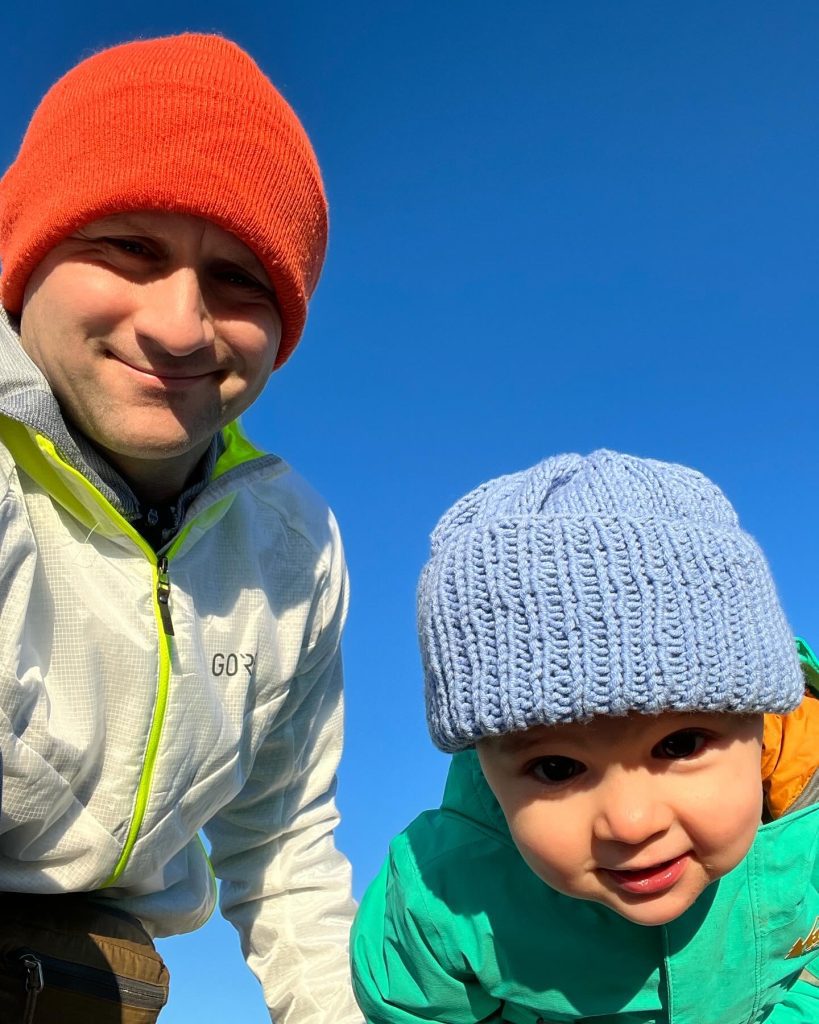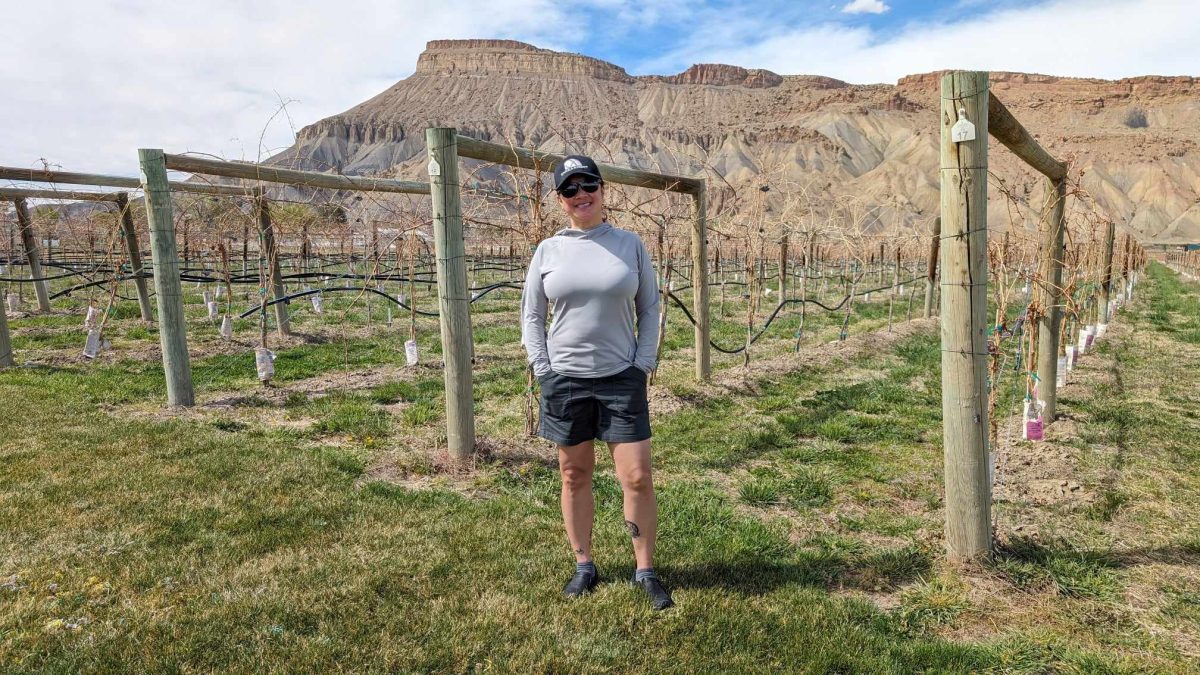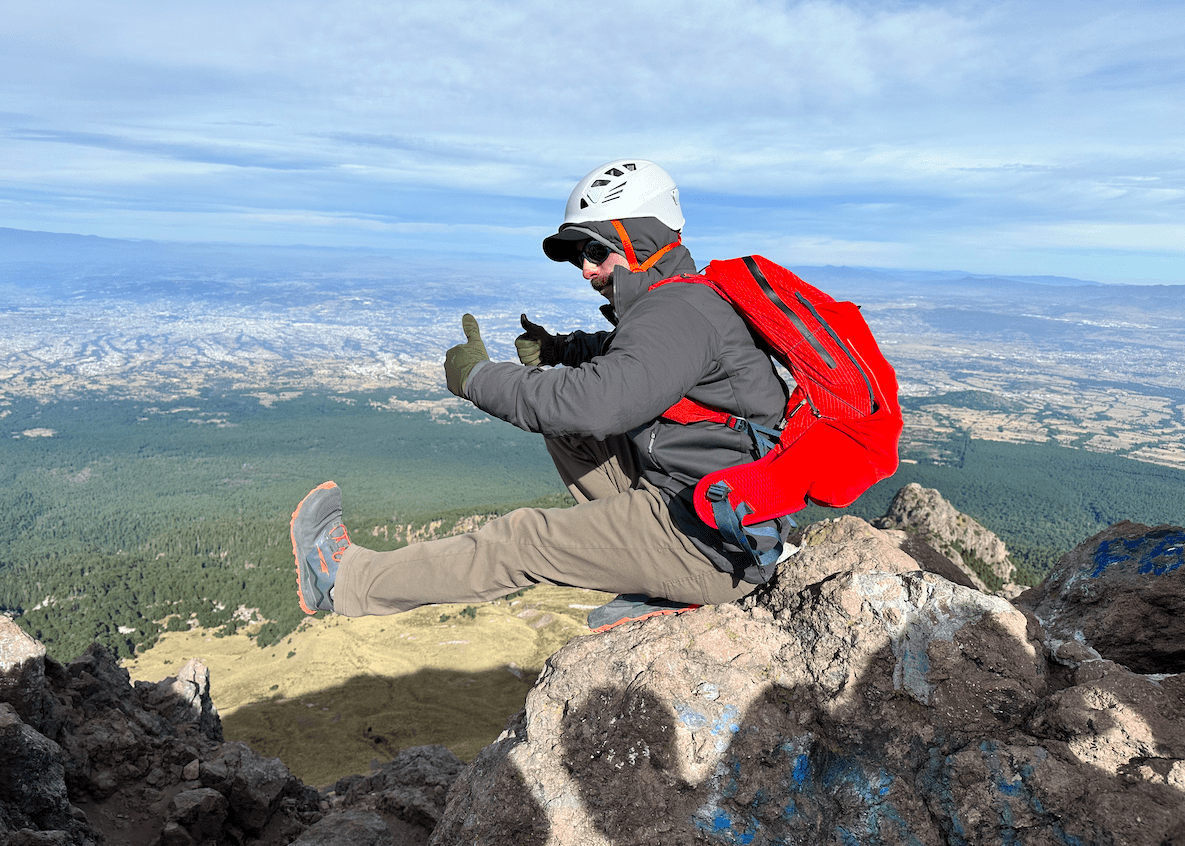Backcountry Ski Kit 2020- Drew’s Favorite Gear
Patagonia Snow Guide Pants
Drew Thayer
Simple soft-shell pants for dry conditions, slim tailoring might not fit everyone.
Thes Patagonia Snow Guide Pants are the simplest softshell pants from Patagonia’s winter ‘19-‘20 lineup. Built out of a softshell fabric, elastic ankle cuffs, and not much else, the Snow Guide pants are workhorse touring pants for dry winter to spring conditions, tailored for skinnier skiers.
The fabric, a nylon/polyester/spandex blend, stretches enough to accommodate movement (even those wide, hip-wrenching kick turns) and sheds light moisture while the DWR lasts. DWR can of course be re-applied (i.e. with Nikwax products), but these should not be confused for waterproof, hard-shell ski pants. That said, the fabric is tough, can handle crampon-tip snags and similar alpine abuse, and in a dry state like Colorado you could ski in them all year.
The ‘features’ are fairly limited, just how I like it. Two zippered front pockets hold keys, bars, etc securely, and two zippered thigh pockets work great for holding my avy beacon. A zippered vent behind each thigh pocket is really nice for climbing; I pretty much always open the vent for skinning and feel comfortable.

These pants have belt loops and removable suspenders. I was skeptical, but I found myself using the suspenders on most tours; they are really comfortable and keep the waistline a bit higher in the back to keep those ‘surprises’ (a.k.a. snow down the backside) at bay.
An additional subtle yet effective feature is a webbing slide-buckle closure at the ankle that lets you cinch the pants up quickly around your boots or a smaller shoe. I found this to be pretty handy at keeping the pants from dragging in the mud while walking around muddy trailheads (or slogging 6 miles into the Gore Range in running shoes).
The only downsides to these pants have to do with the tailoring: they are cut with a slim leg, and the ankle (gaiter and cuff) is slim as well. The ankles really might not fit over a large, well-padded ski boot, and I wouldn’t be surprised if a skier with meaty thighs couldn’t get the sizing right.
Will Patagonia address the slim-fit issue for next year? We’ll have to see. As a tall, lanky guy, these pants fit me really well and I was happy to wear them all season, from sub-freezing powder days to May missions moving light and fast to race the sun to the corn up high.
Rab Guide 2 GTX Glove
$150. A warm, ergonomic glove with large cuffs to keep snow out.
https://rab.equipment/us/guide-2-gtx-glove
This is simply the best winter skiing glove I’ve used. I skid a few seasons in the Rab’s older Guide glove and had some issues with the lack of dexterity and the open wrist cuff – snow would get packed into those gloves all the time. Rab addressed those issues and more with the design of this Guide 2 glove.

The shape is a bit more pre-curved than the original, which makes it easier to grip ski poles (or a mountaineering ax) over the course of a long day. Most importantly, the large cuff with one-handed closures works really well. Making up a considerable portion of the length of the glove, this cuff slides right over whatever jacket I’m wearing, and I can cinch the cuff down for ‘go time’ with a quick motion with the opposite hand. At the base of the run, the cuffs open back up just as easily.
These gloves suit me well from winter conditions to early spring in the Colorado mountains (my hands tend to get cold). The Primaloft Gold insulation is lined with fleece, which just feels warm and cozy on the hands. These gloves have proved plenty durable after one season, and I expect the Pittards leather palms to last many years, especially with periodic treatment with Snow-Seal or a similar leather wax.
While I mainly tested these gloves on ski tours, they’d be a great choice for a belay glove for winter climbing. I can belay, coil a rope, and manipulate carabiners while wearing these thanks to the pre-curved shape, and the leather should stand up to rappelling as my previous Pittards gloves have. A carabiner loop on the middle finger allows these to be carried on the harness.
With warm insulation, durable construction, and easy-to-use oversized wrist cuffs, the Guide 2 GTX gloves will keep your hands warm and dry in cold winter conditions.
Patagonia Micro Puff Hoody
$299. The best warmth-to-weight light puffy out there.
https://www.patagonia.com/product/mens-micro-puff-hoody/84030.html
In terms of warmth-to-weight, this is the most effective piece of insulation I carry in the mountains; it was in my ski pack all winter and spring, and my alpine climbing pack all summer. At 9.3 oz (264 g) in Men’s Medium, this jacket literally weighs as much as some of my older soft-shell jackets but brings the warmth of a true puffy. Since it stuffs into its own pocket it’s easy to carry on a harness on cold rock climbs too.
The thing I like most about this jacket is that it doesn’t try to accomplish two goals at once; it’s just lightweight insulation. Insulated/shell hybrid jackets with durable shell fabrics have become popular (and why not, they offer a ton of utility), but for light-and-fast mountain pursuits where weight matters, an athlete can shed 20-25% of the weight compared to a more shell/hybrid jacket by using a piece like the Micro Puff Hoody, built of feather-weight 0.7 oz, 10 denier Pertex Quantum fabric for both shell and lining. Compare that, for example, to Patagonia’s Nano Puff jacket, built of a more abrasion-resistant 1.4 oz, 20 denier fabric (with 1.3 oz liner fabric). These two jackets, filled with PlumaFill and Primaloft Gold Eco, respectively, are reported to have similar temperature comfort ranges, but the Micro Puff weighs 20-22% lighter depending on size.
This would suggest that a climber or skier carrying the Micro Puff as their insulation piece should consider that it’s not as durable a soft-shell or equivalent layer. While this is true, in practice I haven’t found durability to be an issue. I’ve swiped tree limbs out the way in powder lanes, climbed traditional pitches on rough granite, rappelled the Longs Peak Diamond several times, and bush-whacked out of the dense spruce forests of the Gore Range in an April sleet storm wearing this jacket and it’s no worse for the wear. No, I wouldn’t climb an off-width or chimney wearing it. But who climbs OW in a puffy?

PlumaFill synthetic insulation has been compared directly to goose down (Patagonia) and rated at equivalent fill-power metrics from 650 (Outdoorcrunch.com https://outdoorcrunch.com/nano-puff-vs-micro-puff/) to 850 (Outside online). While these are all hard claims to evaluate specifically, it’s objectively true that PlumaFill is made of longer strands of material than most synthetic insulations, allowing for larger insulation panels, fewer stitches, and ideally fewer cold spots caused by shifting insulation. Anecdotally, this jacket feels about as warm as a 750+ fill-power down jacket of similar loft, with an important caveat: the PlumaFill will retain most of its warmth even if it gets soaking wet. On that drenching slog out of the Gore range I would occasionally take the puffy off, wring it out, and feel warm within minutes of putting it back on.
This jacket is so warm for its weight because it combines top-notch materials in a heat-efficient design. If you size this jacket right it is snug to your body, with elastic at the cuffs and waist sealing in air and a hood that wraps tightly around your head and neck (I’m 6’, skinny and like men’s small for this fit). The jacket still has plenty of sleeve and torso length to allow me to rock climb, but fits really snugly over a medium-weight base-layer, allowing no room for warm air to escape. This means that the hood doesn’t fit over a helmet very well, but that’s fine for me, since this isn’t designed as a full-on belay parka (Patagonia’s Macro Puff Hoody, with a large hood and two-way zipper, is a great option for that). On the coldest climbs I’ll actually wear the hood under the helmet, which works because it’s not very bulky.
The bottom line is that the Micro Puff Hoody, while expensive compared to some other light puffy jackets, is worth it where weight and bulk matter. It has certainly simplified my clothing choices: it’s in my pack for every light-and-fast mission where I expect temps below 50, every season. Rock climbing, skiing, peak bagging, long hikes… it’s so light and low-bulk that it’s easy to bring every time, and it’s about the best warmth-to-weight jacket you can find.
Black Diamond Expedition 3 Ski Pole
$109. Well-designed collapsible ski poles.
BD’s line of time-tested ski poles spans a range of features and uses. Personally, I like their 3-piece “Expedition 3” aluminum option as the best balance between price, durability, weight, and multi-sport utility. They weigh about 1.3 lb per pair at the 62-140 cm length, have removable powder baskets, and a simple mesh wrist strap on a foam grip that works just fine. The 2-piece Expedition 2 pole is $10 cheaper and a hair lighter, but I really like the fact that the 3-piece poles collapse to 22-24” (depending on size), shorter than a backpack. This means when I’m kicking steps up a steep couloir with an ax in one hand, the pole I strapped to my pack isn’t hitting the back of my helmet every time I look up. The 3-piece collapsible poles have more utility for 4-season use: hiking, peak bagging, trekking your climbing gear into base camp, etc.
The Expedition series poles could potentially bend with heavy use, and I’ve seen one snap in a skiing wipeout. For the most durable workhorse touring pole, BD’s Traverse poles are a burly 2-piece option that weigh 12-15% more than the Expedition poles (depending on size) and have a more heavy-duty wrist strap. At $90, these are BD’s most affordable ski pole.
On the other end of the spectrum, the gram-counting aerobically inclined might be interested in Vapor Carbon 2 pole, a 2-piece option weighing just under 1 lb per pair. I am aerobically inclined, and occasionally count grams… but the $170 price tag just isn’t worth it to me.
An accessory worth noting: BD recently introduced a ¾ indexed powder basket that can replace the standard powder baskets on any of their poles (https://www.blackdiamondequipment.com/en_US/ski-poles/3-qtr-indexed-powder-baskets-BD1105640000ALL1.html#start=26). At $8 per pair, these are a cheap addition to your spring backcountry setup. While chasing corn snow this Spring I climbed a lot of steep, bullet-hard slopes just after dawn, and I found that these baskets allowed me to get purchase with my poles on considerably steeper slopes. With the plastic that’s usually in the ‘front’ of the basket gone, the pole can achieve a higher angle to the snow.
Patagonia Capilene Air bottoms $129. Really warm, great temperature range, expensive, poor abrasion resistance.
While admittedly not the most essential piece of skiing kit, base layers are often the unsung heroes of days out in the mountains in winter. I want to comment on Patagonia’s relatively new Capilene Air bottoms, because despite the durability issues with the upper-body version, I found bottoms to be an excellent lower-body base layer for skiing.
Put bluntly, Capilene Air offers a ton of warmth with a steep trade-off in durability. Compared to a synthetic base-layer fabric, this 50/50 blend of polyester and merino wool has substantially more warmth and loft for the same weight. Pulling these leggings on for the first time, they immediately felt different than any other I’ve worn; stretchy and lofty, they feel more like fleece pants, but at a fraction of the bulk. And they’re warm like fleece pants, which is great for skiing in the cold. With that in mind, I was hesitant to wear these leggings on some Spring tours in warmer weather, but was pleasantly surprised to find that the airy structure breathes really well. I’m really impressed with the range of temperatures this fabric can be comfortable in.
The downside of this airy blend is that it really doesn’t stand up to abrasion. At all. It gets ‘pilly’ like a classic wool sweater, but the runs are bigger and faster. The Capilene Air top piece has taken a lot of flak for these durability problems. Light bush-whacking can really pill it up. Rock climb in that piece and you might ruin it. That said, I haven’t found durability to be a problem with the bottoms for winter travel; the abrasion inside my ski pants is minimal, and after a couple dozen days touring last season, the bottoms look good as new.
Bottom line for these bottoms: at $130, these are a pretty specialized piece of clothing. For day-to-day ski touring, anything you can get for 50 bucks at REI will do just fine. That said, the benefits of Capilene Air bottoms could be worth it on alpine climbs, multi-day ski tours, and extended human-powered efforts in cold weather where weight and bulk matter. On the fence about bringing additional fleece pants for those cold nights in the megamid? Capilene air is much warmer than synthetic and you don’t need to bring a second set of leggings. Backcountry skiing in April, when you can expect sub-freezing nights but daytime temps into the 50s? The airy, breathable construction keeps you comfortable in a really wide range of temperatures.
Patagonia R1 Fleece Pullover Hoody, $159. The gold standard in midweight fleece insulation.
https://www.patagonia.com/product/mens-r1-regulator-fleece-pullover-hoody/40069.html
Patagonia had a ‘Done in an R1’ ad campaign last year featuring a list of alpine first ascents—many of them cutting edge—completed over the past few decades by athletes wearing R1 fleece hoodies. The ad speaks for itself; there’s a reason that this mid-weight fleece jacket is ubiquitous in the mountains of Alaska, Europe, and of course Patagonia’s namesake mountain range. The R1 hoody was basically the OG ‘tech’ fleece, a garment built to meet the specific demands of alpine climbing, with a tight hood that can be worn snugly under a helmet, a long hem that stays tucked under a harness while performing athletic movements, and a ‘waffle’-like fleece grid that stays warm while breathing well too.

These climbing-specific details make the R1 stand out as the gold standard in mid-weight insulation for climbers and alpinists. And the name recognition comes with a pretty high price tag. Admittedly, the R1’s specialized features aren’t particularly relevant to the bulk of what people do in the mountains, whether hiking, cross country skiing, or shredding the resort. For most of those activities, an $80 fleece will do just fine. The functional design of the R1 starts to matter more in the vertical world, whether you’re battling spin-drift up a frozen gulley or trying to climb 5.12 on a shaded north wall. Cut with an athletic fit, this jacket stays tight to your body and tucked under your harness, so when you’re fumbling for the right size cam, there aren’t bunches of fabric in the way of your gear loops. The grid fleece is warm for its weight but breathes well too, so I can usually leave it on for both belaying and climbing. It’s also a durable fabric; I’ve climbed several off-width and chimney pitches without any tears. An important detail for me is the sleeves aren’t too baggy – the worst for climbing hand and fist cracks – but are tight to my forearms. On cold walls I zip the hood tight and seal in warmth all the way up my neck. The hood fits great under a helmet and is flexible so I can crane my neck up and down, side to side, without the fabric drifting into my field of vision. This jacket is simply designed really well for climbing, and that’s why it can be found all over the world.
It’s worth noting that the zipper on the R1 migrated from the side of the face to the front of the face some time around 2016, disappointing many R1 afficionados. Around that time I was climbing in a similar layer with an offset zipper made by UK-based Mountain Equipment, and I really enjoyed not having the zipper grate on my lips. That garment, a little lighter, more breathable, and less durable than the R1, sadly got loved to death, but for people looking for a zipper offset across the face, the Eclipse Hooded Zip T is still available, for about the same price as an R1 https://www.mountain-equipment.com/collections/mens-pullovers/products/eclipse-hooded-zip-t. Personally, I’d rather see Patagonia bring back the offset zipper, but it’s not a deal-breaker for me.
Many of the climbing features translate well to backcountry skiing. I like the way the long hem always stays tucked in and the neck zips way up to my nose, like a built-in gaiter for those windy ridges. The hood obviates the need to bring a warm hat on Spring ski tours, since it sits so compactly under my helmet. For anyone into alpine climbing, long backcountry ski tours, and ski mountaineering, an R1 fleece hoody (made in pullover and full-zip versions) is a piece of clothing you will probably find yourself wearing on every adventure.






Leave a Reply